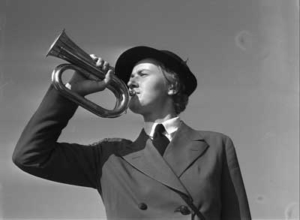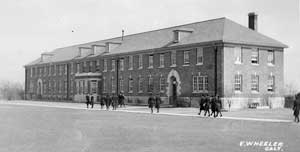Doris Hope
A Wren Remembers
A Wren Remembers
By Doris Grierson Hope

The Wrens’ only known bugler, Daphne Purvey of Duncan, BC, at Galt, Ontario. RCN photo, neg. #R-335. Photo courtesy of the late Muriel Beere, WRCNS.
In July, 1942, the Canadian government gave approval to the creation of the Women’s Royal Canadian Naval Service (W.R.C.N.S.).
Both the Canadian Women’s Army Corps (CWAC), and the Royal Canadian Air Force (Women’s Division) preceded the WRCNS in time, the result it is said of Naval brass looking askance at opening the Navy to women.
However, the exigencies of war and the necessity to make more seamen available for sea duty finally won the day, and women were permitted to serve in the more routine “shore” duties. Some of those women who joined the service in 1942 are still alive, and although their stories are gradually being lost to posterity as numbers dwindle, their contribution to our Canadian culture is now enshrined in our way of life.
To put into effect the organization of the service, Superintendent Dorothy Isherwood, of the British Wrens, the first woman Director of the WRCNS, came to Canada in 1942 and, with two other Wren officers, toured the country interviewing recruits for the first class of Canadian Wrens.
In August of 1942, sixty-seven women met at Kingsmill House on Rideau Street, in Ottawa. One of their instructors was First Officer Doris Taylor, WRNS, a Canadian who had been born in Winnipeg and who it is said was Canada’s first Wren.
Among this first group was Isabel Macneill, who later, as a Lieutenant-Commander, was to become the first female captain of a “ship”, HMCS CONESTOGA, and who, outside royalty, was the first woman entitled to be piped aboard. By mid-September, 1943, Superintendent Isherwood had returned to England, and Commander Adelaide Sinclair (later Acting Captain) became the first Canadian Director of the Wrens, a position which she held until her demobilization in 1946.
The Wren basic training ship at Galt, Ontario, first known as “ByTown II”, and formerly a girl’s rehabilitation school, opened in October, 1942, becoming HMCS CONESTOGA in June 1943 with Lt. Cdr. Macneill its first commanding officer. Their Master-at-Arms, Phyllis “Sandy” Sanderson and her Great Dane kept all new recruits on the run with her “On the Double !” or “Nip to it, Matilda !”
The new recruits were flooded with naval culture, sleeping in quarters with such names as Jellicoe, Nelson, Collingwood, Drake. They paraded, studied, and did kitchen duty. These young women met with a trained beauty expert on their first day “aboard ship”, as recounted in a Toronto Star article of August 17, 1943 entitled “Canada’s Wrens are going to be just as smart-looking as trained beauty experts can make them”.
After four weeks of basic training, as Probationary Wrens they were transferred to their new jobs, or sent for further training to Holwood House in Toronto, to HMCS CORNWALLIS or to HMCS ST. HYACINTHE.
The pay ranged from 90 cents a day for a Probationary Wren to $2.10 a day for a Chief Petty Officer Wren. To this could be added skill pay ranging from 15 to 50 cents a day.

Nelson Block at HMCS CONESTOGA, where Canadian Wrens received basic training. Photo Catalogue No.VRB993.223.2.
By July 1943, the Wren uniform had been settled as navy blue in the winter, light blue in the summer – with a white shirt, black tie, black stockings and black shoes. The original ghastly “pork pie” hat was finally replaced by the tricorn and/or the round rig.
Of course there were those “glamour boots” and “passion pants” that protected our feet and our legs in the winter. But we were the glamour queens of the women’s services (at least we thought so). With our “pochette” (a small uniform issue purse) swinging on our left arm and our Canada badges on our shoulders, we proudly walked even 5th Avenue when in New York.
Clerical work, nursing, and teaching were “women’s occupations” before World War II. During the war the Civil Service in Ottawa drew into its fold women from all over the country to serve as clerks and stenographers.
The call for clerical help brought former teachers from the Eastern Townships of Quebec and from the Prairies to wartime positions – positions from which all were expected to resign upon marriage. In the munitions plants throughout the country, “Rosie the Riveter” was finding her economic niche in Canadian society. Daily, previous boundaries in both women’s occupations and mobility were being broken. Pandora’s box had been opened.
The first occupations available to Wren recruits were those which could immediately release men for active duty. By 1943 these choices had greatly expanded. A Wren rating could then choose from over 20 categories:
Cook, Steward, Wardroom Attendant, Quarters Assistant, Mess Caterer, Supply Assistant, General Clerk, Stenographer, Confidential Book Corrector, Postal Clerk, Secretary, Pay Writer, Administrative Writer, Coder, Telephonist, Telephone Switchboard Operator, Teletype Operator, Plotter, Wireless Telegraphist (W/T), Motor Transport (M/T) Driver, Despatch Rider, Messenger, Sick Berth Attendant.
By 1945 this number of categories had increased to 39. So what category should a raw recruit choose? Since we were all born in the “Great Depression”, we all were aware that a continuing pay cheque meant economic security. (Those were the days before Unemployment Insurance, medical coverage, and the Canada Pension).
In high school, I occasionally wondered about a future vocation in life. I recall looking down that list of occupational categories available to Wrens and stopping when I found “Wireless Telegraphist”. It sounded unusual and challenging. What an opportunity to do something different and to serve my country as well. A quick decision, then it was off to HMCS CONESTOGA for four weeks, (by the way, that trip was my first train ride), and then to the Signal School at ST. HYACINTHE for a six month course in Wireless.
Facilities for Wrens at ST. HYACINTHE in 1943 were abominable. The first classes of Telegraphers were quartered in a convent ashore; the next occupied condemned Army huts still on the station. Sixty Wrens lived in one hut, heated by pot-bellied stoves (which we stoked ourselves), with two bathtubs, four johns, and wash basins for sinks. To make it worse, the water in the pipes froze in the night and then caused a flood the next morning. We were privileged to have our own mess there but it was so cold that we ate in our great coats.
But they were happy days. We learned to jitterbug, fast and furiously. We travelled to Montreal or home on a rare weekend pass, and then we returned on that slow midnight milk train that brought us back to St. Hyacinthe at 2 a.m. With four months of our course behind us, we finally moved into new quarters, but by that time we were almost ready to graduate and to move on as fully-fledged Wireless Telegraphists (Special Operators).

In winter, Lavinia ‘Vin’ Crane and her colleagues faced a trek of half a mile or more to the shacks where they worked. It was their job to try and locate German submarines, using HFDF (high frequency direction finding) equipment.
On to HMCS COVERDALE, a high frequency direction-finding station near Moncton, NB, there to put into use our knowledge of enigmas, cathode ray tubes, heterodynes, etc. With dedication we intercepted German U-boat messages and took bearings on their place of transmission. We knew our work was instrumental in keeping the North Atlantic free for both our Navy and merchant ships. We feared for our comrades when any of those transmissions indicated an enemy sub in the Gulf of St. Lawrence or in our coastal waters.
The weight of our responsibility was constantly with us. On VE day we were thrilled to hear over the wireless those first announcements of the cessation of war. By VJ (Victory in Japan) day, I, like others, was being discharged, to take on a new challenge at university, thanks to those gender-blind re-establishment credits. (Depending on the duration and location of their service, veterans were entitled to a cash gratuity. They could also choose to receive a further re-establishment credit or specialized assistance for vocational training or education.)
Over 6000 Wrens served in World War II. Both in military and civilian life, many male occupations in hazardous locales had been filled by women. By the end of the war, 500 Wrens had served overseas in London, Londonderry, Greenock, Glasgow, Plymouth; with another 500 serving in Newfoundland (then an overseas location) and in Washington, DC.
“Meet The Navy” with its complement of Wren dancers and singers, performed in England and on the continent. HMCS STADACONA in Halifax had three Wren gunners, as well as three Wrens who worked daily aboard HMCS VENTURE, the headquarters for the RCN’s fleet of sub chasing motor launches. Wren Signallers guided ships into Halifax harbour. Signal Towers and W/T stations were ‘womanned’ solely by Wrens.
In Newfoundland, Wren Pay Writers with their Pay Officers went aboard corvettes and other ships as they came into harbour. A Wren officer served as staff driver to the Chief of Naval Staff, Admiral Percy Nelles. The tradition against women’s presence on naval warships was broken when Lt. Cdr. Nancy Pyper and Lt. Agnes McPhee returned from England aboard HMCS OTTAWA in 1945.
After VE day, volunteers for Pacific duty flooded in from all categories. However, VJ day came quickly in August, 1945, and by July 1946 the WRCNS went out of existence. However, a new group of Wrens enlisted for the Korean War. Sixty officers and 650 ratings were re-established under Cdr. Macneill as Staff Officer (Wrens) to the Chief of Naval Personnel. In 1951 these post-war Wrens went to HMCS CORNWALLIS for basic training. CONESTOGA, which had been the basic training ship for the first Wrens, now reopened as the Conestoga block in the naval training ship CORNWALLIS. In 1957, Isabel Macneill retired from service for the second time, but not before the RCN had been established with women enlisting for “Continuous Naval Duty” and not before equal pay for equal rank had been achieved. The route had finally been paved for entry of our daughters, as well as our sons, into regular service with the Canadian Armed Forces.
Articles
Hours
7 Days a Week: 10:00 am – 3:30 pm
Monday to Friday: 10:00 am – 3:30 pm
Hours
Monday to Friday: 8:00 am – 4:00 pm
To confirm if we are open, please call (250) 363-5655 or (250) 363-4312
Naval & Military Museum
Info@NavalAndMilitaryMuseum.org
CFB ESQUIMALT NAVAL & MILITARY MUSEUM
PO Box 17000 Stn Forces
Victoria, BC V9A 7N2